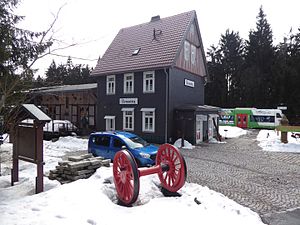Rennsteig train station
| Rennsteig | |
|---|---|
 Rennsteig station reception building
|
|
| Data | |
| Location in the network | former connection station |
| Design | Terminus |
| Platform tracks | 4th |
| abbreviation | UREN |
| IBNR | 8012749 |
| opening | 1904 |
| Website URL | www.rennsteigbahn.de |
| location | |
| City / municipality | Suhl |
| Place / district | Schmiedefeld am Rennsteig |
| country | Thuringia |
| Country | Germany |
| Coordinates | 50 ° 36 '54 " N , 10 ° 50' 6" E |
| Height ( SO ) | 747.7 m |
| Railway lines | |
|
|
| Railway stations in Thuringia | |
The station Rennsteig is a station on the Rennsteigbahn in the Thuringian Forest . It is one of the highest railway stations in Thuringia and is 747 meters above sea level between Stützerbach ( Ilmenau ) and Schmiedefeld ( Suhl ) at kilometer 33.38 on the railway line from Plaue to Themar , the middle section of which is the Rennsteigbahn.
history
The station was laid out in 1904, the station building dates from 1906. Between 1913 and 1965 there was a small train to Frauenwald , which began at Rennsteig station. The last scheduled travel through the station took place in 1998. Today it is used for events and “nostalgic trips ” by the steam train friends Mittlerer Rennsteig . Since June 15, 2014, the station has been back to scheduled traffic for a limited period until 2017 (trial operation). On weekends and public holidays, the "RennsteigShuttle" of the Süd-Thüringen-Bahn runs on the northern part of the Rennsteigbahn with four pairs of trains that extend the line STB 46 Erfurt - Ilmenau via Ilmenau-Bad, Manebach and Stützerbach to the Rennsteig train station. With the 2017/2018 timetable change, this trial operation returned to normal operation. In the course of the restart, bus routes to Oberhof and Masserberg as well as Vesser and Frauenwald were set up, which are coordinated with the train schedule.
The train station at the top of the Thuringian Forest
Rennsteig train station is a terminus . This was necessary for operational reasons, because initially cogwheel locomotives were used on the route , which always had to stand downhill to prevent the wagon coupling from breaking . Due to the hairpin bend at the apex of the railway line, the cogwheel locomotives automatically stood downhill without having to move. In 1927 the company switched from gear operation to friction operation. In addition, the pulling of the trains over the steep section was permitted, so that a corresponding track in the station was necessary to bypass the trains. The terminus at the apex of the railway line was still necessary because, on steam locomotives, the smoke outlet must always point uphill in order to avoid too low a water level in the boiler .
The fact that the Rennsteig train station forms the apex of the Rennsteigbahn is also made clear by a sign that indicates a watershed : the track to Stützerbach is labeled Elbe , on the track to Schmiedefeld there is a label Weser . During the renovation of the station building, the incline of the roof was changed in order to accommodate another floor. In autumn 2007, the former pillars of the roofing of platform 8 of Erfurt main station were rebuilt with a new wooden roof construction over platform 1 of Rennsteig station.
Picture gallery
n-car in Rennsteig, 1998










